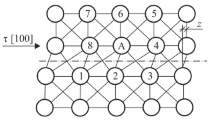Summary
The site model theory (SMT) is shown to lead to the same deformation behaviour as that displayed by the standard linear solid (SLS), group I, for all loading conditions. If a second deformation mechanism (inter-molecular slip) is introduced the result is the same as that obtained with the standard linear solid, group II, and models the behaviour of a polymer melt near to the solidification temperature.
Zusammenfassung
Es wird gezeigt, daß ein einfaches Platzwechsel-Modell (site model theory) bei allen Belastungsbedingungen das gleiche Deformationsverhalten voraussagt wie der lineare Drei-Parameter-Festkörper (standard linear solid, group I). Wenn ein weiterer Deformationsmechanismus (zwischenmolekulare Gleitung) eingeführt wird, entspricht das Verhalten dagegen demjenigen einer linearen Drei-Parameter-Flüssigkeit (standard linear solid, group II), welche das Verhalten einer Polymerschmelze in der Nähe der Schmelztemperatur beschreibt.
Similar content being viewed by others
Abbreviations
- a :
-
=ω 012 +ω 021 , see eq. [1]
- b :
-
=N 01 ω 012 (V 12 +V 21), see eq. [1]
- c :
-
= 2N s ω 0 V s see eq. [6]
- k :
-
Boltzmann constant
- t :
-
time
- E,E 1,E 2 :
-
spring constants, see figures 1 and 3
- E u :
-
unrelaxed modulus
- N 01 :
-
site 1 equilibrium population in the unstressed state
- N s :
-
number of units available for slip
- ΔN(t):
-
decrease in site 1 population
- ΔN s (t):
-
net number of slip jumps in the stressaided direction
- T :
-
temperature (K)
- V i,j :
-
activation volume for jumps in directioni → j
- V s :
-
activation volume for the slip process
- ε :
-
strain
- \(\dot \varepsilon \) :
-
strain rate
- Δε :
-
incremental change in strain per unit change in site population
- µ,µ 1,µ 2 :
-
dashpot constants, see figures 1 and 3
- σ :
-
applied stress
- σ 0 :
-
initial applied stress, (stress relaxation) =σ(t) (creep)
- Δσ :
-
incremental change in stress per unit change in site population
- ω 0 :
-
jump rate for slip in the unstressed state
- ω 0 i,j :
-
jump rate in the directioni → j in the unstressed state
References
Zener, C., Elasticity and Anelasticity of Metals. Univ. of Chicago Press (Chicago 1948).
Ward, I. M., Mechanical Properties of Solid Polymers. Wiley (London 1971).
Arridge, R. G. C., Mechanics of Polymers. Clarendon (Oxford 1975).
Kocks, U. F., Argon, A. S., and Ashbee, M. F., “Thermodynamics and Kinetics of Slip”, in: B. Chalmers, J. W. Christian, and T. B. Massalski (eds.), Prog. Mater. Sci.19, Pergamon (Oxford 1975).
Krausz, A. S. and Eyring, H., Deformation Kinetics. Wiley-Intersci. (New York 1975).
Argon, A. S., Phil. Mag.28, 839 (1973).
Escaig, B., Ann. Phys.3, 207 (1978).
Kubát, J., Rigdahl, M., and Seldén, R., J. Appl. Polym. Sci.20, 2799 (1976).
Pink, E., Rev. Deform. Behav. Mater.2, 37 (1977).
White, J. R., Submitted for publication.
White, J. R., Mater Sci. Eng.45, 35 (1980).
White, J. R., Submitted for publication.
Author information
Authors and Affiliations
Additional information
With 3 figures and 3 tables
Rights and permissions
About this article
Cite this article
White, J.R. The site model theory and the standard linear solid. Rheol Acta 20, 23–28 (1981). https://doi.org/10.1007/BF01517469
Received:
Revised:
Issue Date:
DOI: https://doi.org/10.1007/BF01517469



